Magnetic Evolution of Carrier Doping and Spin Dynamics in Diluted Magnetic Semiconductors (Ba,Na)(Zn,Mn)2As2
Abstract
1. Introduction
2. Results
2.1. Structural Characterization
2.2. Magnetization and Magnetic Critical Behaviors
2.3. Magnetic Ground State
3. Materials and Methods
4. Discussion and Conclusions
Author Contributions
Funding
Data Availability Statement
Acknowledgments
Conflicts of Interest
References
- Gu, G.; Zhao, G.; Lin, C.; Li, Y.; Jin, C.; Xiang, G. Asperomagnetic order in diluted magnetic semiconductor (Ba,Na)(Zn,Mn)2As2. Appl. Phys. Lett. 2018, 112, 032402. [Google Scholar] [CrossRef]
- Furdyna, J.K. Diluted magnetic semiconductors. J. Appl. Phys. 1988, 64, R29. [Google Scholar] [CrossRef]
- Dietl, T.; Ohno, H. Dilute ferromagnetic semiconductors: Physics and spintronic structures. Rev. Mod. Phys. 2014, 86, 187–251. [Google Scholar] [CrossRef]
- Zhao, G.; Deng, Z.; Jin, C. Advances in new generation diluted magnetic semiconductors with independent spin and charge doping. J. Semicond. 2019, 80, 081505. [Google Scholar] [CrossRef]
- Žutić, I.; Fabian, J.; Sarma, S.D. Spintronics Fundamentals and applications. Rev. Mod. Phys. 2004, 76, 323. [Google Scholar]
- Jungwirth, T.; Wunderlich, J.; Novák, V.; Olejník, K.; Olejník, K.; Gallagher, B.L.; Campion, R.P.; Edmonds, K.W. Spin-dependent phenomena and device concepts explored in (Ga,Mn)As. Rev. Mod. Phys. 2014, 86, 855–896. [Google Scholar] [CrossRef]
- Dietl, T.; Bonanni, A.; Ohno, H. Families of magnetic semiconductors—An overview. J. Semicond. 2019, 40, 080301. [Google Scholar] [CrossRef]
- Jungwirth, T.; Sinova, J.; Mašek, J.; Kučera, J.; MacDonald, A.H. Theory of ferromagnetic (III,Mn)V semiconductors. Rev. Mod. Phys. 2006, 78, 809–864. [Google Scholar] [CrossRef]
- Ohno, H.; Shen, A.; Matsukura, F.; Oiwa, A.; Endo, A.; Katsumoto, S.; Iye, Y. (Ga,Mn)As: A new diluted magnetic semiconductor based on GaAs. Appl. Phys. Lett. 1996, 69, 363. [Google Scholar] [CrossRef]
- Chen, L.; Yang, X.; Yang, F.; Zhao, J.; Misuraca, J.; Xiong, P.; von Molnar, S. Enhancing the Curie temperature of ferromagnetic semiconductor (Ga,Mn)As to 200 K via nanostructure engineering. Nano Lett. 2011, 11, 2584–2589. [Google Scholar] [CrossRef]
- Samarth, N. Ferromagnetic semicondutors: Battle of the bands. Nat. Mater. 2012, 11, 360–361. [Google Scholar] [CrossRef]
- Masek, J.; Kudrnovsky, J.; Maca, F.; Gallagher, B.L.; Campion, R.P.; Gregory, D.H.; Jungwirth, T. Dilute moment n-type ferromagnetic semiconductor Li(Zn,Mn)As. Phys. Rev. Lett. 2007, 98, 067202. [Google Scholar] [CrossRef] [PubMed]
- Deng, Z.; Jin, C.Q.; Liu, Q.Q.; Wang, X.C.; Zhu, J.L.; Feng, S.M.; Chen, L.C.; Yu, R.C.; Arguello, C.; Goko, T.; et al. Li(Zn,Mn)As as a new generation ferromagnet based on a I-II-V semiconductor. Nat. Commun. 2011, 2, 422. [Google Scholar] [CrossRef] [PubMed]
- Deng, Z.; Zhao, K.; Gu, B.; Han, W.; Zhu, J.L.; Wang, X.C.; Li, X.; Liu, Q.Q.; Yu, R.C.; Goko, T.; et al. Diluted ferromagnetic semiconductor Li(Zn,Mn)P with decoupled charge and spin doping. Phys. Rev. B 2013, 88, 081203. [Google Scholar] [CrossRef]
- Ding, C.; Man, H.; Qin, C.; Lu, J.; Sun, Y.; Wang, Q.; Yu, B.; Feng, C.; Goko, T.; Arguello, C.J.; et al. (La1−xBax)(Zn1−xMnx)AsO: A two-dimensional 1111-type diluted magnetic semiconductor in bulk form. Phys. Rev. B 2013, 88, 041102. [Google Scholar] [CrossRef]
- Ding, C.; Qin, C.; Man, H.Y.; Imai, T.; Ning, F.L. NMR investigation of the diluted magnetic semiconductor Li(Zn1-xMnx)P (x=0.1). Phys. Rev. B 2013, 88, 041108. [Google Scholar] [CrossRef]
- Han, W.; Zhao, K.; Wang, X.; Liu, Q.; Ning, F.; Deng, Z.; Liu, Y.; Zhu, J.; Ding, C.; Man, H.; et al. Diluted ferromagnetic semiconductor (LaCa)(ZnMn)SbO isostructural to “1111” type iron pnictide superconductors. Sci. China Phys. Mech. Astron. 2013, 56, 2026–2030. [Google Scholar] [CrossRef]
- Lu, J.; Man, H.; Ding, C.; Wang, Q.; Yu, B.; Guo, S.; Wang, H.; Chen, B.; Han, W.; Jin, C.; et al. The synthesis and characterization of 1111-type diluted magnetic semiconductors (La1−xSrx)(Zn1−xTMx)AsO (TM = Mn, Fe, Co). Europhys. Lett. 2013, 103, 67011. [Google Scholar] [CrossRef]
- Yang, X.; Li, Y.; Shen, C.; Si, B.; Sun, Y.; Tao, Q.; Cao, G.; Xu, Z.; Zhang, F. Sr and Mn co-doped LaCuSO: A wide band gap oxide diluted magnetic semiconductor with Tc around 200 K. Appl. Phys. Lett. 2013, 103, 022410. [Google Scholar] [CrossRef]
- Yang, X.; Li, Y.; Zhang, P.; Jiang, H.; Luo, Y.; Chen, Q.; Feng, C.; Cao, C.; Dai, J.; Tao, Q.; et al. K and Mn co-doped BaCd2As2: A hexagonal structured bulk diluted magnetic semiconductor with large magnetoresistance. J. Appl. Phys. 2013, 114, 223905. [Google Scholar] [CrossRef]
- Zhao, K.; Deng, Z.; Wang, X.C.; Han, W.; Zhu, J.L.; Li, X.; Liu, Q.Q.; Yu, R.C.; Goko, T.; Frandsen, B.; et al. New diluted ferromagnetic semiconductor with Curie temperature up to 180 K and isostructural to the ‘122’ iron-based superconductors. Nat. Commun. 2013, 4, 1442. [Google Scholar] [CrossRef]
- Chen, B.J.; Zhao, K.; Deng, Z.; Han, W.; Zhu, J.L.; Wang, X.C.; Liu, Q.Q.; Frandsen, B.; Liu, L.; Cheung, S.; et al. (Sr,Na)(Zn,Mn)2As2: A diluted ferromagnetic semiconductor with the hexagonal CaAl2Si2 type structure. Phys. Rev. B 2014, 90, 155202. [Google Scholar] [CrossRef]
- Ding, C.; Gong, X.; Man, H.; Zhi, G.; Guo, S.; Zhao, Y.; Wang, H.; Chen, B.; Ning, F.L. The suppression of Curie temperature by Sr doping in diluted ferromagnetic semiconductor (La1−xSrx)(Zn1−yMny)AsO. Europhys. Lett. 2014, 107, 17004. [Google Scholar] [CrossRef]
- Man, H.; Qin, C.; Ding, C.; Wang, Q.; Gong, X.; Guo, S.; Wang, H.; Chen, B.; Ning, F.L. (Sr3La2O5)(Zn1−xMnx)2As2: A bulk form diluted magnetic semiconductor isostructural to the “32522” Fe-based superconductors. Europhys. Lett. 2014, 105, 67004. [Google Scholar] [CrossRef]
- Ning, F.L.; Man, H.; Gong, X.; Zhi, G.; Guo, S.; Ding, C.; Wang, Q.; Goko, T.; Liu, L.; Frandsen, B.A.; et al. Suppression of Tc by overdoped Li in the diluted ferromagnetic semiconductor Li1+y(Zn1−xMnx)P: A μSR investigation. Phys. Rev. B 2014, 90, 085123. [Google Scholar] [CrossRef]
- Yang, X.; Chen, Q.; Li, Y.; Wang, Z.; Bao, J.; Li, Y.; Tao, Q.; Cao, G.; Xu, Z.-A. Sr0.9K0.1Zn1.8Mn0.2As2: A ferromagnetic semiconductor with colossal magnetoresistance. EPL (Europhys. Lett.) 2014, 107, 67007. [Google Scholar] [CrossRef]
- Zhao, K.; Chen, B.; Zhao, G.; Yuan, Z.; Liu, Q.; Deng, Z.; Zhu, J.; Jin, C. Ferromagnetism at 230 K in (Ba0.7K0.3)(Zn0.85Mn0.15)2As2 diluted magnetic semiconductor. Chin. Sci. Bull. 2014, 59, 2524–2527. [Google Scholar] [CrossRef]
- Zhao, K.; Chen, B.J.; Deng, Z.; Han, W.; Zhao, G.Q.; Zhu, J.L.; Liu, Q.Q.; Wang, X.C.; Frandsen, B.; Liu, L.; et al. (Ca,Na)(Zn,Mn)2As2: A new spin and charge doping decoupled diluted ferromagnetic semiconductor. J. Appl. Phys. 2014, 116, 163906. [Google Scholar] [CrossRef]
- Man, H.; Guo, S.; Sui, Y.; Guo, Y.; Chen, B.; Wang, H.; Ding, C.; Ning, F.L. Ba(Zn1-2xMnxCux)2As2: A Bulk Form Diluted Ferromagnetic Semiconductor with Mn and Cu Codoping at Zn Sites. Sci. Rep. 2015, 5, 15507. [Google Scholar] [CrossRef]
- Suzuki, H.; Zhao, G.Q.; Zhao, K.; Chen, B.J.; Horio, M.; Koshiishi, K.; Xu, J.; Kobayashi, M.; Minohara, M.; Sakai, E.; et al. Fermi surfaces and p−d hybridization in the diluted magnetic semiconductor Ba1−xKx(Zn1−yMny)2As2 studied by soft x-ray angle-resolved photoemission spectroscopy. Phys. Rev. B 2015, 92, 235120. [Google Scholar] [CrossRef]
- Suzuki, H.; Zhao, K.; Shibata, G.; Takahashi, Y.; Sakamoto, S.; Yoshimatsu, K.; Chen, B.J.; Kumigashira, H.; Chang, F.H.; Lin, H.J.; et al. Photoemission and x-ray absorption studies of the isostructural to Fe-based superconductors diluted magnetic semiconductor (Ba1−xKx)(Zn1−yMny)2As2. Phys. Rev. B 2015, 91, 140401. [Google Scholar] [CrossRef]
- Chen, B.; Deng, Z.; Li, W.; Gao, M.; Li, Z.; Zhao, G.; Yu, S.; Wang, X.; Liu, Q.; Jin, C. (Sr1-xNax)(Cd1-xMnx)2As2: A new charge and spin doping decoupled diluted magnetic semiconductors with CaAl2Si2-type structure. J. Appl. Phys. 2016, 120, 083902. [Google Scholar] [CrossRef]
- Chen, B.; Deng, Z.; Li, W.; Gao, M.; Liu, Q.; Gu, C.Z.; Hu, F.X.; Shen, B.G.; Frandsen, B.; Cheung, S.; et al. New Fluoride-arsenide Diluted Magnetic Semiconductor (Ba,K)F(Zn,Mn)As with Independent Spin and Charge Doping. Sci. Rep. 2016, 6, 36578. [Google Scholar] [CrossRef]
- Chen, B.; Deng, Z.; Li, W.; Gao, M.; Zhao, J.; Zhao, G.; Yu, S.; Wang, X.; Liu, Q.; Jin, C. Li(Zn,Co,Mn)As: A bulk form diluted magnetic semiconductor with Co and Mn co-doping at Zn sites. AIP Adv. 2016, 6, 115014. [Google Scholar] [CrossRef]
- Ding, C.; Guo, S.; Zhao, Y.; Man, H.; Fu, L.; Gu, Y.; Wang, Z.; Liu, L.; Frandsen, B.A.; Cheung, S.; et al. The synthesis and characterization of 1111 type diluted ferromagnetic semiconductor (La1-xCax)(Zn1-xMnx)AsO. J. Phys. Condens. Matter 2016, 28, 026003. [Google Scholar] [CrossRef]
- Frandsen, B.A.; Gong, Z.; Terban, M.W.; Banerjee, S.; Chen, B.; Jin, C.; Feygenson, M.; Uemura, Y.J.; Billinge, S.J.L. Local atomic and magnetic structure of dilute magnetic semiconductor(Ba,K)(Zn,Mn)2As2. Phys. Rev. B 2016, 94, 094102. [Google Scholar] [CrossRef]
- Guo, S.; Man, H.; Gong, X.; Ding, C.; Zhao, Y.; Chen, B.; Guo, Y.; Wang, H.; Ning, F.L. (Ba1−xKx)(Cu2−xMnx)Se2: A copper-based bulk form diluted magnetic semiconductor with orthorhombic BaCu2S2-type structure. J. Magn. Magn. Mater. 2016, 400, 295–299. [Google Scholar] [CrossRef]
- Guo, S.; Zhao, Y.; Gong, X.; Man, H.; Ding, C.; Zhi, G.; Fu, L.; Gu, Y.; Wang, H.; Chen, B.; et al. La(Zn1−2xMnxCux)AsO: A 1111-type diluted magnetic semiconductor with manganese and copper codoping at Zn sites. Europhys. Lett. 2016, 114, 57008. [Google Scholar] [CrossRef]
- Guo, S.L.; Zhao, Y.; Man, H.Y.; Ding, C.; Gong, X.; Zhi, G.X.; Fu, L.C.; Gu, Y.L.; Frandsen, B.A.; Liu, L.; et al. μSR investigation of a new diluted magnetic semiconductor Li(Zn,Mn,Cu)As with Mn and Cu codoping at the same Zn sites. J. Phys. Condens. Matter 2016, 28, 366001. [Google Scholar] [CrossRef]
- Sun, F.; Li, N.N.; Chen, B.J.; Jia, Y.T.; Zhang, L.J.; Li, W.M.; Zhao, G.Q.; Xing, L.Y.; Fabbris, G.; Wang, Y.G.; et al. Pressure effect on the magnetism of the diluted magnetic semiconductor (Ba1−xKx)(Zn1−yMny)2As2 with independent spin and charge doping. Phys. Rev. B 2016, 93, 224403. [Google Scholar] [CrossRef]
- Sun, F.; Xu, C.; Yu, S.; Chen, B.-J.; Zhao, G.-Q.; Deng, Z.; Yang, W.-G.; Jin, C.-Q. Synchrotron X-Ray Diffraction Studies on the New Generation Ferromagnetic Semiconductor Li(Zn,Mn)As under High Pressure. Chin. Phys. Lett. 2017, 34, 067501. [Google Scholar] [CrossRef]
- Sun, F.; Zhao, G.Q.; Escanhoela, C.A.; Chen, B.J.; Kou, R.H.; Wang, Y.G.; Xiao, Y.M.; Chow, P.; Mao, H.K.; Haskel, D.; et al. Hole doping and pressure effects on the II-II-V-based diluted magnetic semiconductor (Ba1−xKx)(Zn1−yMny)2As2. Phys. Rev. B 2017, 95, 094412. [Google Scholar] [CrossRef]
- Wang, R.; Huang, Z.X.; Zhao, G.Q.; Yu, S.; Deng, Z.; Jin, C.Q.; Jia, Q.J.; Chen, Y.; Yang, T.Y.; Jiang, X.M.; et al. Out-of-plane easy-axis in thin films of diluted magnetic semiconductor Ba1−xKx(Zn1−yMny)2As2. AIP Adv. 2017, 7, 045017. [Google Scholar] [CrossRef]
- Zhao, G.Q.; Zhao, G.Q.; Lin, C.J.; Deng, Z.; Gu, G.X.; Yu, S.; Wang, X.C.; Gong, Z.Z.; Uemura, Y.J.; Li, Y.Q.; et al. Single Crystal Growth and Spin Polarization Measurements of Diluted Magnetic Semiconductor (BaK)(ZnMn)2As2. Sci. Rep. 2017, 7, 14473. [Google Scholar] [CrossRef]
- Zhao, Y.; Wang, K.; Guo, S.; Fu, L.; Gu, Y.; Zhi, G.; Xu, L.; Cui, Q.; Cheng, J.; Wang, H.; et al. La(Zn1−2xMnxCux)SbO: A new diluted magnetic semiconductor isostructural to 1111-type iron pnictide superconductors. EPL (Europhys. Lett.) 2017, 120, 47005. [Google Scholar] [CrossRef]
- Surmach, M.A.; Chen, B.J.; Deng, Z.; Jin, C.Q.; Glasbrenner, J.K.; Mazin, I.I.; Ivanov, A.; Inosov, D.S. Weak doping dependence of the antiferromagnetic coupling between nearest-neighbor Mn2+ spins in (Ba1−xKx)(Zn1−yMny)2As2. Phys. Rev. B 2018, 97, 104418. [Google Scholar] [CrossRef]
- Zhao, G.Q.; Li, Z.; Sun, F.; Yuan, Z.; Chen, B.J.; Yu, S.; Peng, Y.; Deng, Z.; Wang, X.C.; Jin, C.Q. Effects of high pressure on the ferromagnetism and in-plane electrical transport of (Ba0.904K0.096)(Zn0.805Mn0.195)2As2 single crystal. J. Phys. Condens. Matter 2018, 30, 254001. [Google Scholar] [CrossRef] [PubMed]
- Fu, L.; Gu, Y.; Guo, S.; Wang, K.; Zhang, H.; Zhi, G.; Liu, H.; Xu, Y.; Wang, Y.; Wang, H.; et al. Ferromagnetism in fluoride-antimonide SrF(Zn1-2xMnxCux)Sb with a quasi two dimensional structure. J. Magn. Magn. Mater. 2019, 483, 95–99. [Google Scholar] [CrossRef]
- Han, W.; Chen, B.J.; Gu, B.; Zhao, G.Q.; Yu, S.; Wang, X.C.; Liu, Q.Q.; Deng, Z.; Li, W.M.; Zhao, J.F.; et al. Li(Cd,Mn)P: A new cadmium based diluted ferromagnetic semiconductor with independent spin & charge doping. Sci. Rep. 2019, 9, 7490. [Google Scholar]
- Peng, Y.; Yu, S.; Zhao, G.Q.; Li, W.M.; Zhao, J.F.; Cao, L.P.; Wang, X.C.; Liu, Q.Q.; Zhang, S.J.; Yu, R.Z.; et al. Effects of chemical pressure on diluted magnetic semiconductor (Ba,K)(Zn,Mn)2As2. Chin. Phys. B 2019, 28, 057501. [Google Scholar] [CrossRef]
- Yu, S.; Zhao, G.; Peng, Y.; Zhu, X.; Wang, X.; Zhao, J.; Cao, L.; Li, W.; Li, Z.; Deng, Z.; et al. A substantial increase of Curie temperature in a new type of diluted magnetic semiconductors via effects of chemical pressure. APL Mater. 2019, 7, 10. [Google Scholar] [CrossRef]
- Gu, Y.; Zhang, H.; Zhang, R.; Fu, L.; Wang, K.; Zhi, G.; Guo, S.; Ning, F.L. A novel diluted magnetic semiconductor (Ca,Na)(Zn,Mn)2Sb2 with decoupled charge and spin dopings. Chin. Phys. B 2020, 29, 057507. [Google Scholar] [CrossRef]
- Shen, X.; Deng, Z.; Li, Z.; Gu, B.; He, L.H.; Yao, Y.; Jin, C.Q.; Yu, R.C. Effects of structure modulation on the magnetic properties in diluted magnetic semiconductor Li1+yZn0.9Mn0.1As1.0. Phys. Rev. Mater. 2020, 4, 094412. [Google Scholar] [CrossRef]
- Yu, S.; Liu, X.; Zhao, G.; Peng, Y.; Wang, X.; Zhao, J.; Li, W.; Deng, Z.; Furdyna, J.K.; Uemura, Y.J.; et al. Anomalous critical point behavior in dilute magnetic semiconductor (Ca,Na)(Zn,Mn)2Sb2. Phys. Rev. Mater. 2020, 4, 024411. [Google Scholar] [CrossRef]
- Yu, S.; Zhao, G.; Peng, Y.; Wang, X.; Liu, Q.; Yu, R.; Zhang, S.; Zhao, J.; Li, W.; Deng, Z.; et al. (Ba,K)(Zn,Mn)2Sb2: A New Type of Diluted Magnetic Semiconductor. Crystals 2020, 10, 690. [Google Scholar] [CrossRef]
- Sakamoto, S.; Zhao, G.Q.; Shibata, G.; Deng, Z.; Zhao, K.; Wang, X.C.; Nonaka, Y.; Ikeda, K.; Chi, Z.D.; Wan, Y.X.; et al. Anisotropic Spin Distribution and Perpendicular Magnetic Anisotropy in a Layered Ferromagnetic Semiconductor (Ba,K)(Zn,Mn)2As2. ACS Appl. Electron. Mater. 2021, 3, 789–794. [Google Scholar] [CrossRef]
- Zhang, H.J.; Zhang, R.F.; Fu, L.C.; Gu, Y.L.; Zhi, G.X.; Dong, J.O.; Zhao, X.Q.; Ning, F.L. (La1-xSrx)(Zn1-xMnx)SbO: A novel 1111-type diluted magnetic semiconductor. Acta Physica. Sinica. 2021, 70, 107501. [Google Scholar] [CrossRef]
- Zhi, G.; Guo, S.; Zhang, R.; Zhao, Y.; Fu, L.; Gu, Y.; Wang, K.; Zhang, H.; Zhao, X.; Dong, J.; et al. Cu2(Zn,Mn)(Sn,Al)Se4: A diluted magnetic semiconductor with decoupled charge and spin doping. J. Magn. Magn. Mater. 2021, 536, 168064. [Google Scholar] [CrossRef]
- Dong, J.; Zhao, X.; Fu, L.; Gu, Y.; Zhang, R.; Yang, Q.; Xie, L.; Ning, F. (Ca,K)(Zn,Mn)2As2: Ferromagnetic semiconductor induced by decoupled charge and spin doping in CaZn2As2. J. Semicond. 2022, 43, 072501. [Google Scholar] [CrossRef]
- Gu, Y.; Zhang, R.; Zhang, H.; Fu, L.; Zhi, G.; Dong, J.; Zhao, X.; Xie, L.; Ning, F. A CaAl2Si2-Type Magnetic Semiconductor (Sr,Na)(Zn,Mn)2Sb2 Isostructural to 122-Type Iron-Based Superconductors. Adv. Condens. Matter Phys. 2022, 2022, 4291923. [Google Scholar] [CrossRef]
- Suzuki, H.; Zhao, G.; Okamoto, J.; Sakamoto, S.; Chen, Z.-Y.; Nonaka, Y.; Shibata, G.; Zhao, K.; Chen, B.; Wu, W.-B.; et al. Magnetic Properties and Electronic Configurations of Mn Ions in the Diluted Magnetic Semiconductor Ba1−xKx(Zn1−yMny)2As2 Studied by X-ray Magnetic Circular Dichroism and Resonant Inelastic X-ray Scattering. J. Phys. Soc. Jpn. 2022, 91, 064710. [Google Scholar] [CrossRef]
- Zhang, R.; Xu, C.; Fu, L.; Gu, Y.; Zhi, G.; Dong, J.; Zhao, X.; Xie, L.; Zhang, H.; Cao, C.; et al. Manipulation of the ferromagnetic ordering in magnetic semiconductor (La,Ca)(Zn,Mn)AsO by chemical pressure. J. Magn. Magn. Mater. 2022, 554, 169276. [Google Scholar] [CrossRef]
- Zhao, X.; Dong, J.; Fu, L.; Gu, Y.; Zhang, R.; Yang, Q.; Xie, L.; Tang, Y.; Ning, F. (Ba1−xNax)F(Zn1−xMnx)Sb: A novel fluoride-antimonide magnetic semiconductor with decoupled charge and spin doping. J. Semicond. 2022, 43, 112501. [Google Scholar] [CrossRef]
- Yu, S.; Peng, Y.; Zhao, G.; Zhao, J.; Wang, X.; Zhang, J.; Deng, Z.; Jin, C.Q. Colossal negative magnetoresistance in spin glass Na(Zn,Mn)Sb. J. Semicond. 2023, 44, 032501. [Google Scholar] [CrossRef]
- Peng, Y.; Li, X.; Shi, L.; Zhao, G.; Zhang, J.; Zhao, J.; Wang, X.; Gu, B.; Deng, Z.; Uemura, Y.J.; et al. A Near Room Temperature Curie Temperature in a New Type of Diluted Magnetic Semiconductor (Ba,K)(Zn,Mn)2As2. Adv. Phys. Res. 2025, 4, 2400124. [Google Scholar] [CrossRef]
- Peng, Y.; Peng, Y.; Shi, L.; Zhao, G.; Zhang, J.; Zhao, J.; Wang, X.; Deng, Z.; Jin, C.Q. Colossal Magnetoresistance in Layered Diluted Magnetic Semiconductor Rb(Zn,Li,Mn)4As3 Single Crystals. Nanomaterials 2024, 14, 263. [Google Scholar] [CrossRef]
- Zhao, G.Q.; Bo, G.; Kojima, K.M.; Cai, Y.P.; Li, X.; Peng, Y.; Zhao, K.; Guo, S.L.; Han, W.; Yongqing Li, Y.Q.; et al. Doping effects on magnetic evolution and transport properties in (Ba,Rb)(Zn,Mn)2As2. Nanomaterials. under review.
- Hirohata, A.; Sukegawa, H.; Yanagihara, H.; Zutic, I.; Seki, T.; Mizukami, S.; Swaminathan, R. Roadmap for Emerging Materials for Spintronic Device Applications. IEEE Trans. Magn. 2015, 51, 0800511. [Google Scholar] [CrossRef]
- Eggenkamp, P.J.T.; Swagten, H.J.M.; Story, T.; Litvinov, V.I.; Swuste, C.H.W.; Dejonge, W.J.M. Calculations of the ferromagnet-to-spin-glass transition in diluted magnetic systems with an RKKY interaction. Phys. Rev. B 1995, 51, 15250–15259. [Google Scholar] [CrossRef]
- Ferrand, D.; Cibert, J.; Wasiela, A.; Bourgognon, C.; Tatarenko, S.; Fishman, G.; Andrearczyk, T.; Jaroszyński, J.; Koleśnik, S.; Dietl, T.; et al. Carrier-induced ferromagnetism in p−Zn1−xMnxTe. Phys. Rev. B 2001, 63, 085201. [Google Scholar] [CrossRef]
- Topping, C.V.; Blundell, S.J.A.C. susceptibility as a probe of low-frequency magnetic dynamics. J. Phys. Condens. Matter 2019, 31, 013001. [Google Scholar] [CrossRef] [PubMed]
- Yaouanc, A.; de Réotier, P.D.; Rotation, M.S. Relaxation, and Resonance: Applications to Condensed Matter; Oxford University Press: Oxford, UK, 2010. [Google Scholar]
- Amato, A.; Morenzoni, E. Introduction to Muon Spin Spectroscopy: Applications to Solid State and Material Sciences; Springer: Berlin/Heidelberg, Germany, 2024. [Google Scholar]
- Blundell, S.J. Spin-polarized muons in condensed matter physics. Contemp. Phys. 1999, 40, 175–192. [Google Scholar] [CrossRef]
- Uemura, Y.J.; Yamazaki, T.; Harshman, D.R.; Senba, M.; Ansaldo, E.J. Muon-spin relaxation in AuFe and CuMn spin glasses. Phys. Rev. B 1985, 31, 546–563. [Google Scholar] [CrossRef] [PubMed]
- Balz, C.; Lake, B.; Reuther, J.; Luetkens, H.; Schönemann, R.; Herrmannsdörfer, T.; Singh, Y.; Nazmul Islam, A.T.M.; Wheeler, E.M.; Rodriguez-Rivera, J.A.; et al. Physical realization of a quantum spin liquid based on a complex frustration mechanism. Nat. Phys. 2016, 12, 942–949. [Google Scholar] [CrossRef]
- Coey, J.M.D. Magnetism and Magnetic Materials; Cambridge University Press: Cambridge, UK, 2010. [Google Scholar]
- Coey, J.M.D.; Freitas, P.P.; Plaskett, T.S.; von Molnar, S. Giant transverse hysteresis in an asperomagnet. Phys. Rev. B 1990, 41, 9585–9587. [Google Scholar] [CrossRef]
- Tissier, B.; Buder, R.; Coey, J.M.D. Domains in an asperomagnet: Amorphous DyCu. J. Magn. Magn. Mater. 1980, 15, 1393–1394. [Google Scholar] [CrossRef]
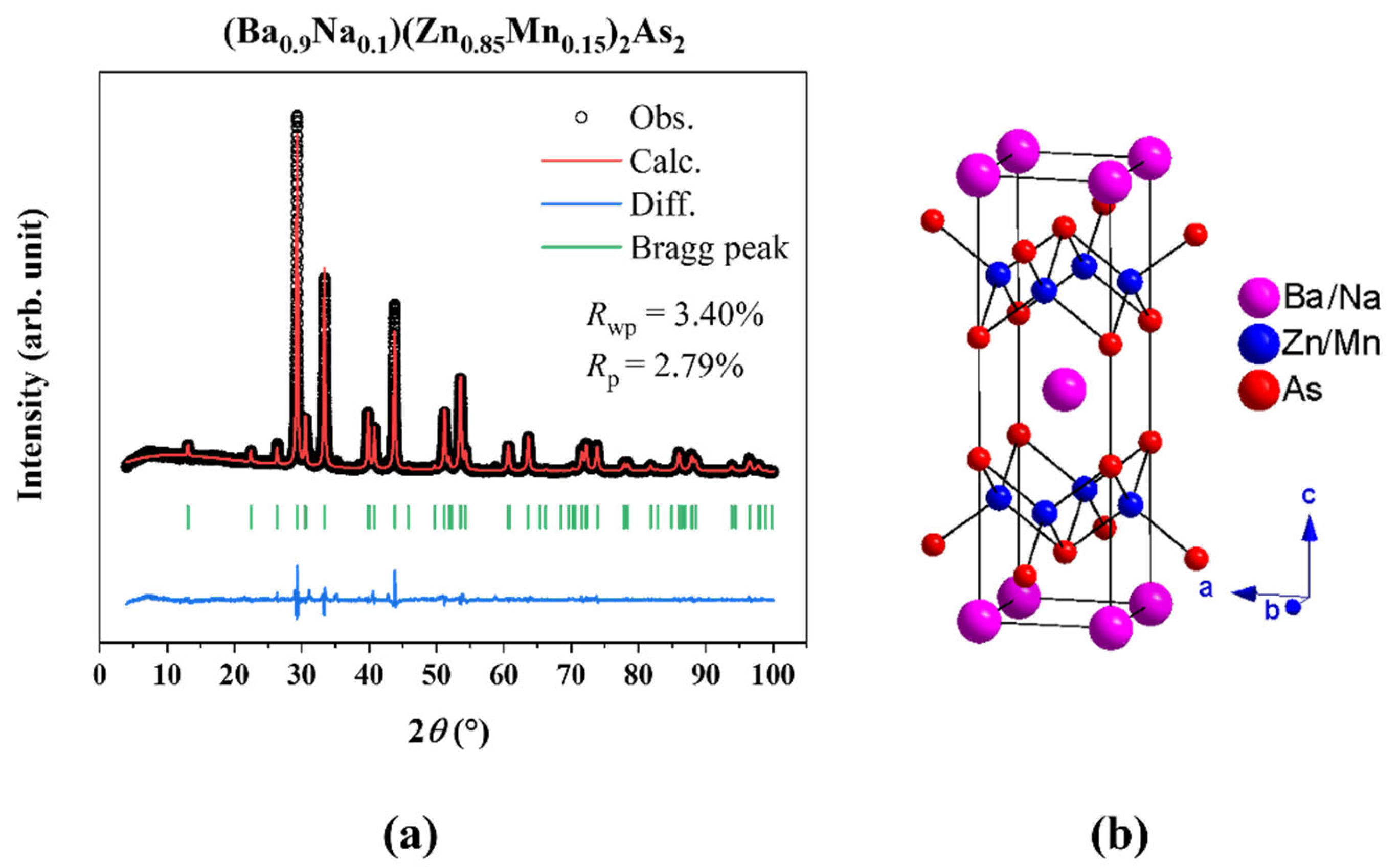
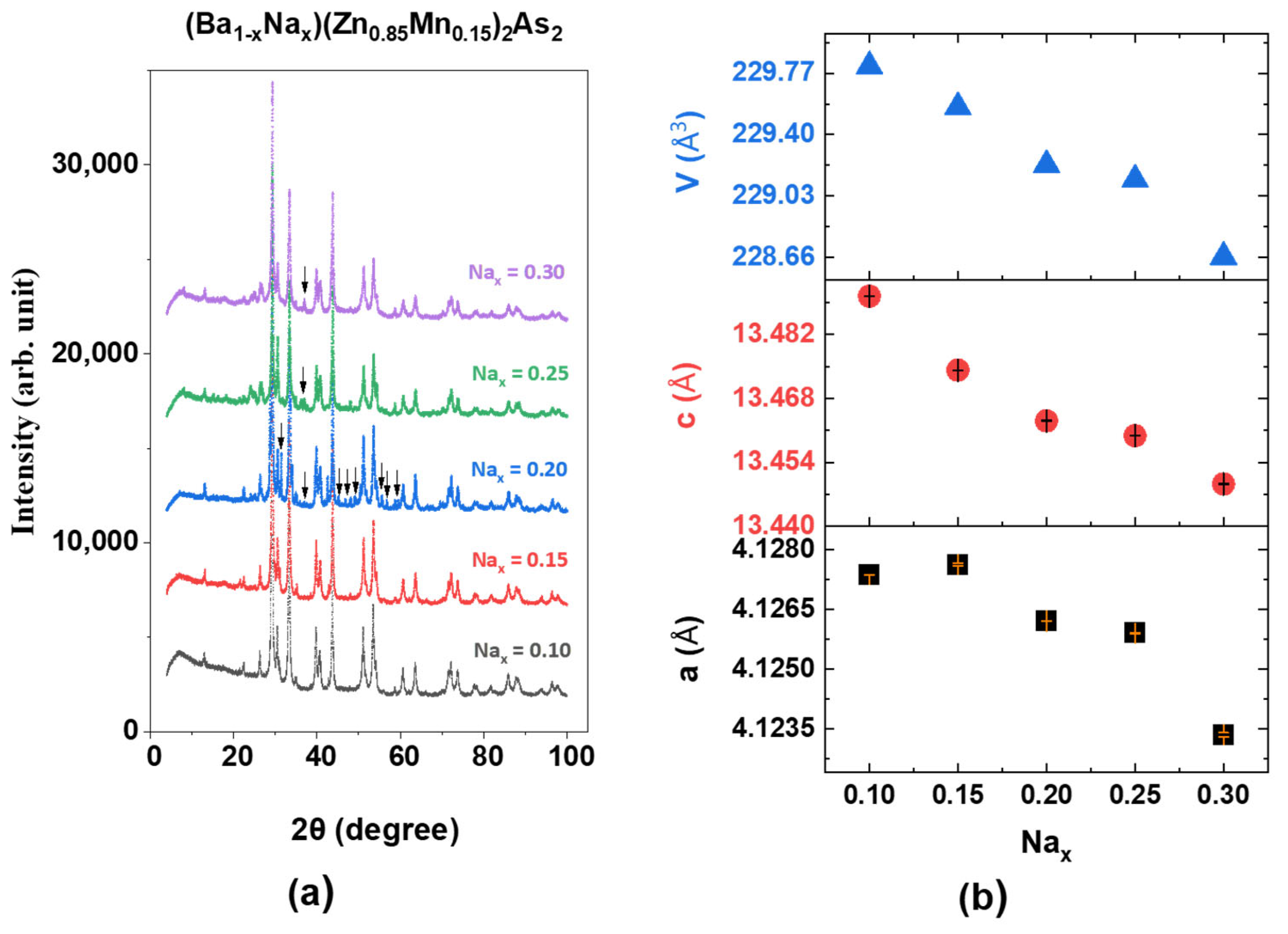
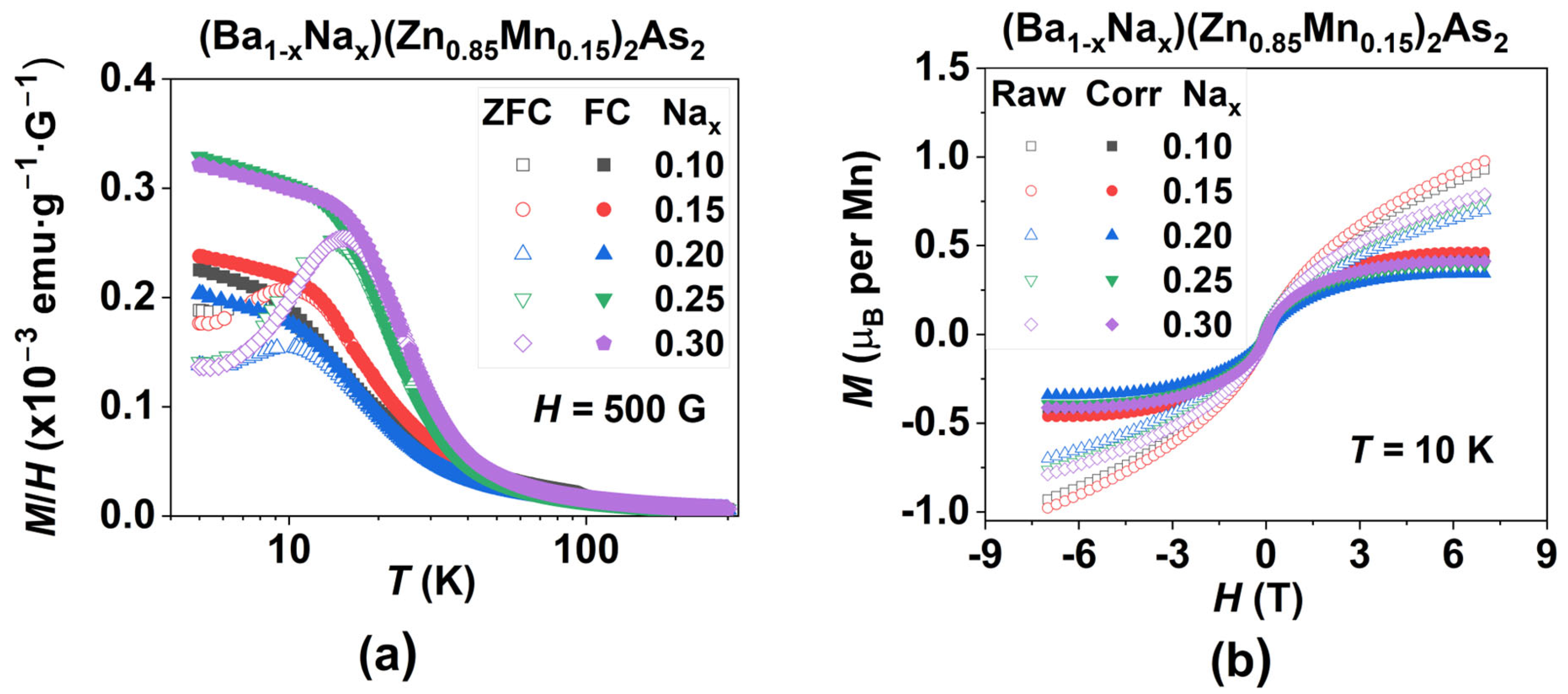

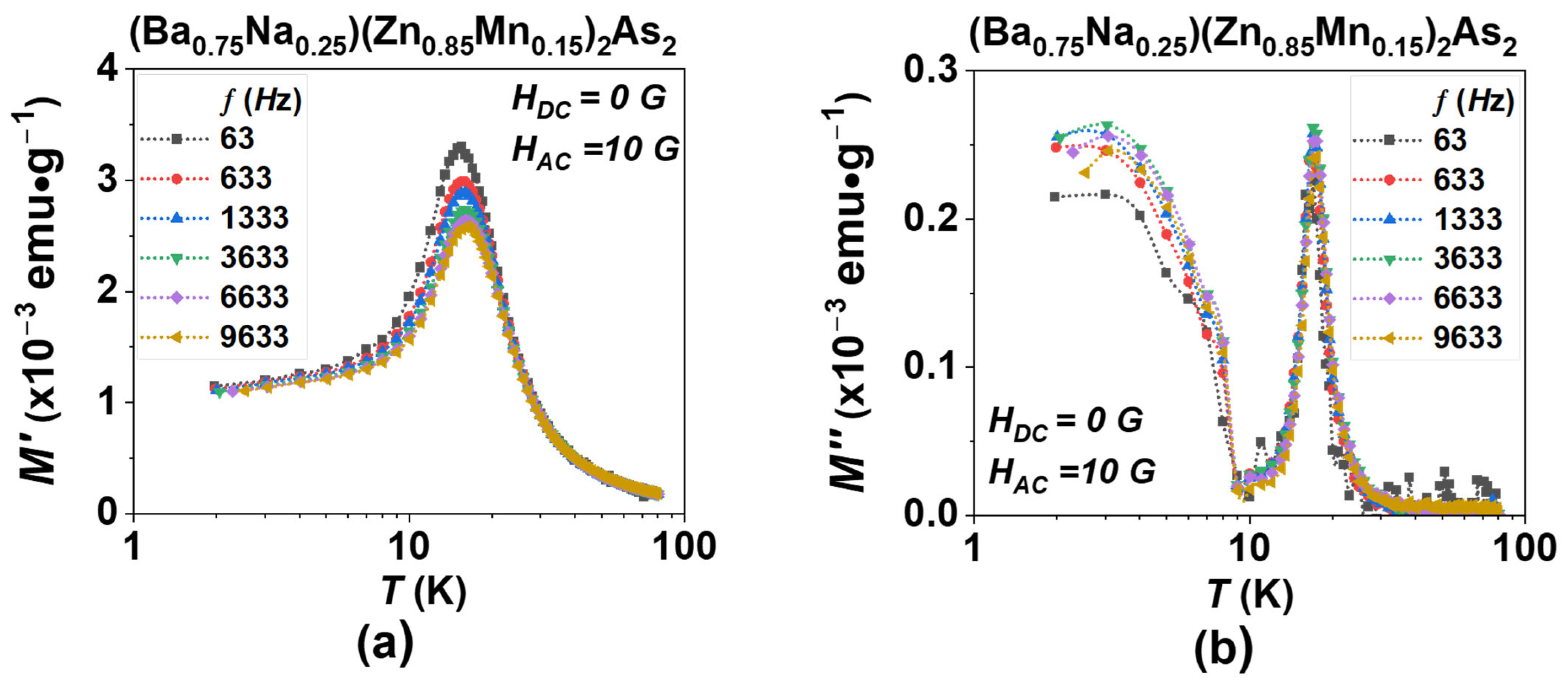

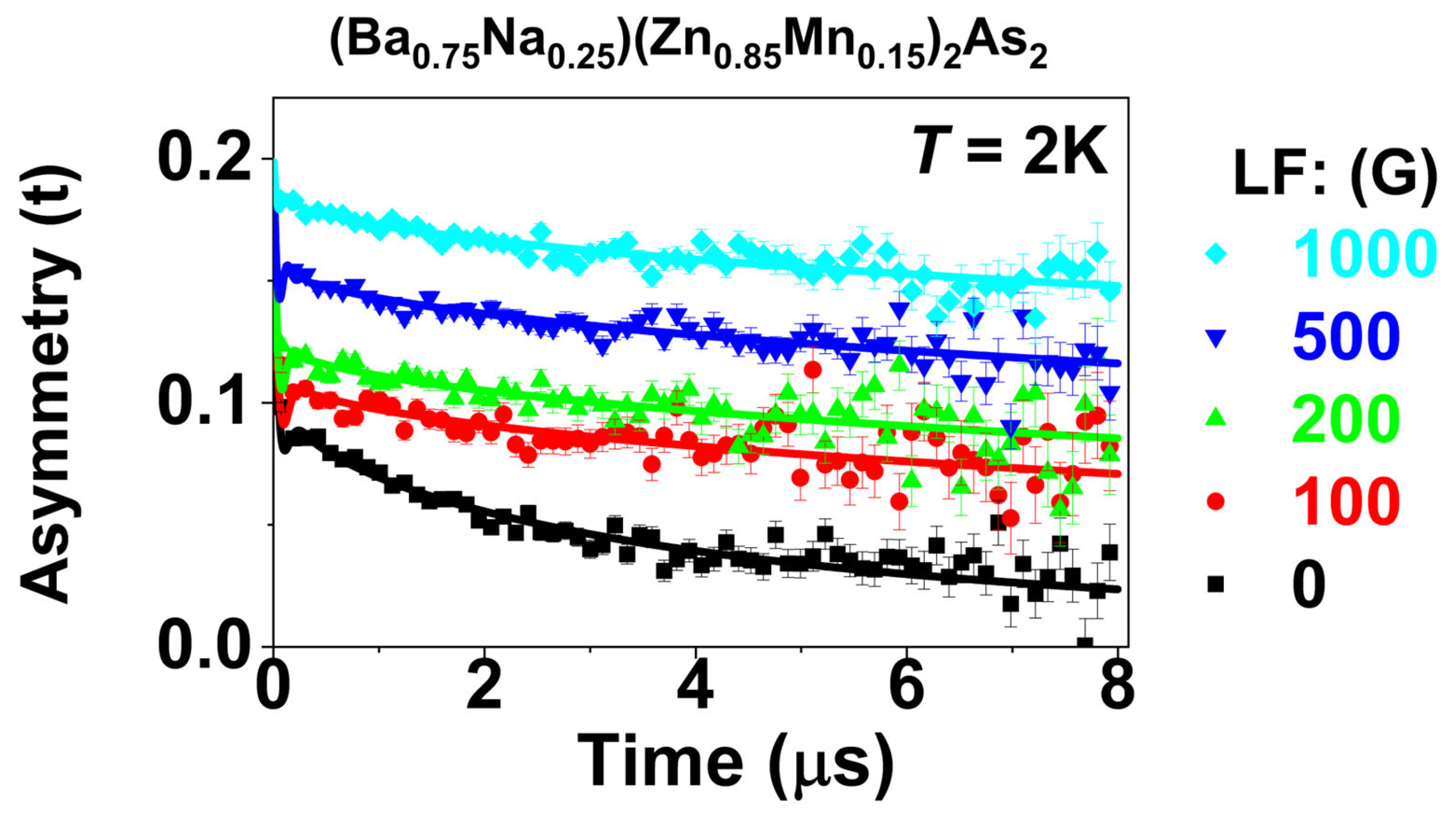
Disclaimer/Publisher’s Note: The statements, opinions and data contained in all publications are solely those of the individual author(s) and contributor(s) and not of MDPI and/or the editor(s). MDPI and/or the editor(s) disclaim responsibility for any injury to people or property resulting from any ideas, methods, instructions or products referred to in the content. |
© 2025 by the authors. Licensee MDPI, Basel, Switzerland. This article is an open access article distributed under the terms and conditions of the Creative Commons Attribution (CC BY) license (https://creativecommons.org/licenses/by/4.0/).
Share and Cite
Zhao, G.; Cai, Y.; Kojima, K.M.; Sheng, Q.; Beare, J.; Luke, G.; Li, X.; Peng, Y.; Ziman, T.; Zhao, K.; et al. Magnetic Evolution of Carrier Doping and Spin Dynamics in Diluted Magnetic Semiconductors (Ba,Na)(Zn,Mn)2As2. Condens. Matter 2025, 10, 30. https://doi.org/10.3390/condmat10020030
Zhao G, Cai Y, Kojima KM, Sheng Q, Beare J, Luke G, Li X, Peng Y, Ziman T, Zhao K, et al. Magnetic Evolution of Carrier Doping and Spin Dynamics in Diluted Magnetic Semiconductors (Ba,Na)(Zn,Mn)2As2. Condensed Matter. 2025; 10(2):30. https://doi.org/10.3390/condmat10020030
Chicago/Turabian StyleZhao, Guoqiang, Yipeng Cai, Kenji M. Kojima, Qi Sheng, James Beare, Graeme Luke, Xiang Li, Yi Peng, Timothy Ziman, Kan Zhao, and et al. 2025. "Magnetic Evolution of Carrier Doping and Spin Dynamics in Diluted Magnetic Semiconductors (Ba,Na)(Zn,Mn)2As2" Condensed Matter 10, no. 2: 30. https://doi.org/10.3390/condmat10020030
APA StyleZhao, G., Cai, Y., Kojima, K. M., Sheng, Q., Beare, J., Luke, G., Li, X., Peng, Y., Ziman, T., Zhao, K., Deng, Z., Wang, X., Li, Y., Su, G., Maekawa, S., Gu, B., Uemura, Y. J., & Jin, C. (2025). Magnetic Evolution of Carrier Doping and Spin Dynamics in Diluted Magnetic Semiconductors (Ba,Na)(Zn,Mn)2As2. Condensed Matter, 10(2), 30. https://doi.org/10.3390/condmat10020030





